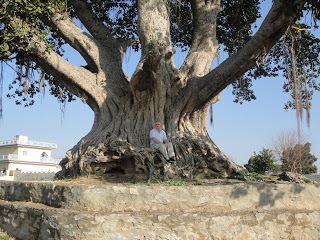Respect
Wednesday, May 25, 2011
Over to my wife Sue for this blog, which is all about Respect.
“With respect” is one of those phrases I really dislike. Usually it’s said when people are irritated and disagree with you, and respect is actually not very much on their agenda. Nevertheless respect is a word we often hear bandied about. There are comments like “No self respecting person would wear that,” we hear talk of “Respect needing to be earned”, of young people having “no respect”. So are there in fact lots of different kinds of respect?

As a child I wore a hat when I went to church as I was told it was respectful. I hadn’t a clue what it meant but I went along with it. Most of my friends wore a hat as well so it made me one of the crowd.
Later on as rebellious teenagers we joined together to show we didn’t respect things, certainly not things that “old" people thought important! So no hats for us, unless we made them part of the outrageous fashions we felt were our own!
Here’s how I think about respect, and why I think it’s so important.
I was fortunate to grow up in an environment that taught me I was as good as, but no better than anyone else. This was some intrinsic quality, not related to wealth, status, looks or any of the other parameters we measure ourselves by.
When we are born, to develop to our maximum potential, everyone deserves to be respected by, and to respect, everyone else. And what a perfect world it would be if that continued to happen as we grew!!
But none of us live in a perfect world, so how are we going to manage?
If we all deserve respect, but we feel disrespected by someone in, for example, a relationship or in work, what is actually happening? Someone is not treating us right but should that actually affect our own self-respect? No it shouldn’t - unless we allow it to. Here are two wonderful comments confirming this.
‘They cannot take away our self-respect if we do not give it to them.’ ~Mahatma Gandhi
‘No one can make you feel inferior without your consent.’
If my self-respect is strong and someone treats me badly it’s not my fault - it’s theirs. It tells us more about the other person than it does about ourselves. We might feel angry or sad or even scared but that again is to do with the other persons actions. It is only when our self-respect is low we mistakenly blame ourselves.
We can think of our self-respect as a core of positive energy, a bright light that will always be there. It might be weaker or stronger at different times in our lives, but it is always there. And we need to feed it by being with positive people as much as we can.
We cannot always choose to be with people who treat us well . But sometimes we can remind such people that we don’t need to tolerate their behaviour. For example, if someone is shouting at you in what you believe to be an unreasonable manner you can say something like, “I do not like or deserve to be shouted at. If you want to speak to me let’s start again.” It won’t always work – and if it doesn’t, we can tell ourselves we did our best and are obviously at a higher level of personal development than our attackers!

Little things can be very important measures of respect – greeting people with a handshake, smiling, anything that helps the other person feel valued. I was away at the weekend with my daughter and her partner and their 4 month old son. He is their first child and I happily spent the weekend listening to them talking and singing to him, about how wonderful, funny and cute he is. He was surrounded by a cocoon of total acceptance for who he was.
Now that’s what I call respect!
 0
Like
Published at 8:06 PM Comments (1)
0
Like
Published at 8:06 PM Comments (1)
Under the Banyan Tree
Tuesday, May 10, 2011
Recently I visited Pakistan with a group of doctors from Liverpool. We were there to develop research links. I was also keen to find out how they run health care in rural areas.
Before we left I was very conscious of the troubled times people are living through, with political instability and natural disasters like last summer’s devastating floods in the Indus Valley. These were evident, but by no means oppressive, during our visit to Islamabad and Rawalpindi. We didn't know that Osama Bin Laden was living nearby!
Much more in evidence were the strengths and resilience of the country, and the people we met. A rolling hilly landscape, dotted with stupas, temples and shrines arising from a rich, diverse cultural heritage much older than ours in the West. A brief but memorable meeting with Dr Tariq Mehmood. He’s a rural medic who works with few resources beyond his own knowledge and skills, yet provides the sort of patient-based care with which I feel great affinity. And wherever we went, generosity and hospitality beyond measure.

But I was most captivated by the Banyan Trees. Most villages in the region have at least one. One village we passed has six Banyans grouped together.
Banyans are fig trees, which start life as seeds germinating in the crevices of other trees. Once established they can live for hundreds of years, sometimes more than a thousand. They are immense. Deep, deep roots come above the surface and provide natural (and remarkably comfortable) places to sit and rest. Branches spread outwards and upwards into the sky, seemingly forever, and their green leathery leaves offer shade from the baking sunshine.
Sitting under the Banyan Tree I feel at ease, secure, sheltered. I have a clear vision of the world around me. I also have an awareness of the immense strength and solidity of the tree, an undeniably tangible, peaceful, natural being who has seen it all before, and has survived and flourished. I imagine it offering its wisdom and protection to me, and whoever else wishes to rest under its care.
It doesn't surprise me that Buddha found enlightenment while meditating under the Banyan Tree, or that Krishna should choose a Banyan leaf as his final resting place. I can see why Shiva is commonly depicted as sitting in silence under the Banyan, with wise people at his feet.
And I can see why Robinson Crusoe decided to make his home in one.
A Banyan Tree is a wonderful refuge in times of trouble.
 0
Like
Published at 12:51 PM Comments (2)
0
Like
Published at 12:51 PM Comments (2)
Spam post or Abuse? Please let us know
|
|